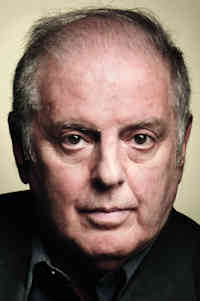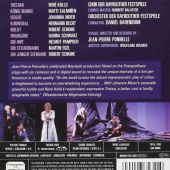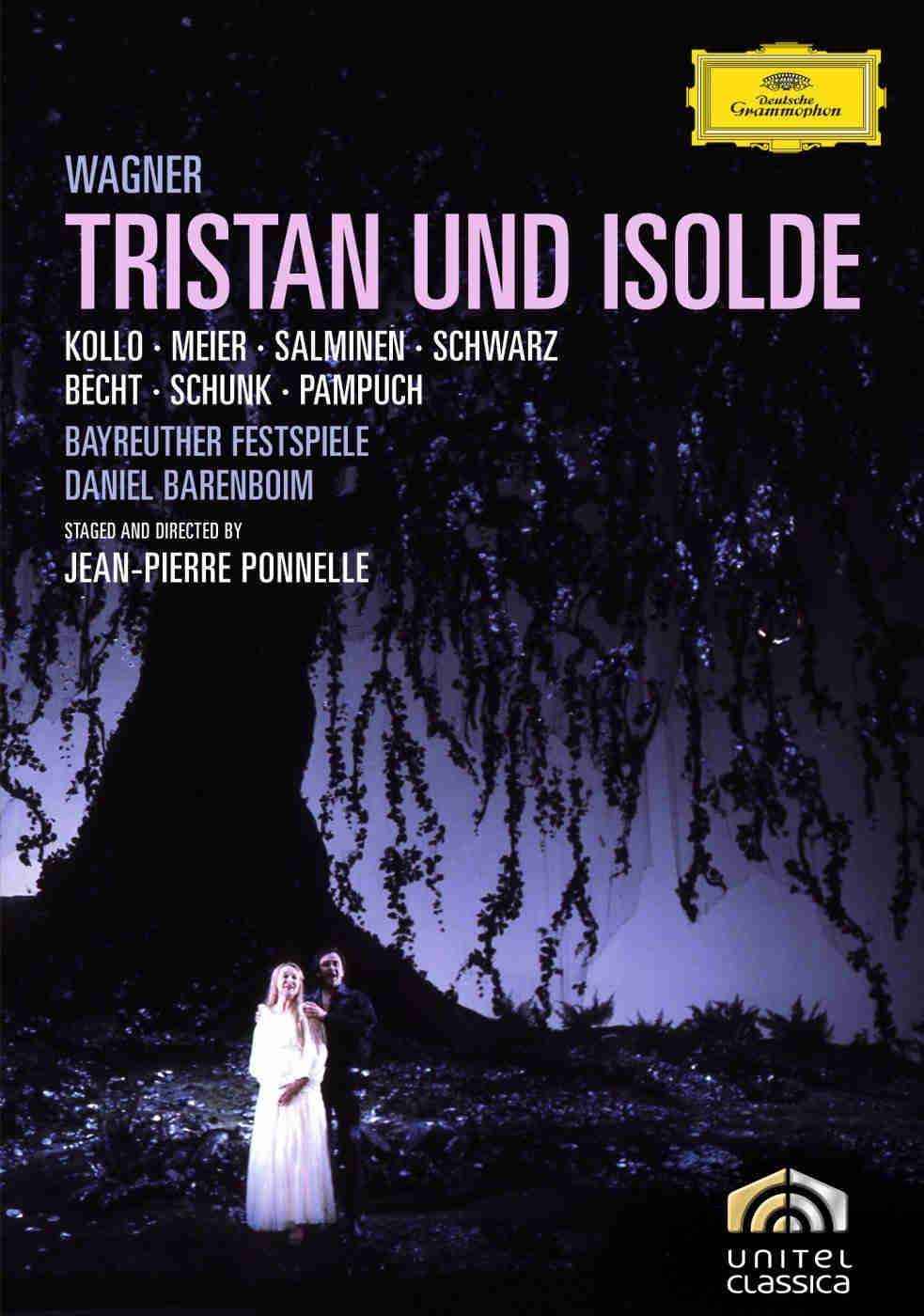Tristan und Isolde

| Daniel Barenboim | |||||
| Chor und Orchester der Bayreuther Festspiele | ||||||
Date/Location
Recording Type
|
| Tristan | René Kollo |
| Isolde | Johanna Meier |
| Brangäne | Hanna Schwarz |
| Kurwenal | Hermann Becht |
| König Marke | Matti Salminen |
| Melot | Robert Schunk |
| Ein junger Seemann | Robert Schunk |
| Ein Hirt | Helmut Pampuch |
| Steuermann | Martin Egel |
| Stage director | Jean-Pierre Ponnelle |
| Set designer | Jean-Pierre Ponnelle |
| TV director | Jean-Pierre Ponnelle |
PRODUCTION
Live performance from the shrine. Sets and costumes are representative rather than literal. Ponelle’s staging is dramatic and effective. Unfortunately, the overall effect is flat.
PERFORMANCES
Barenboim directs a leisurely, almost soporific reading emphasizing poetry rather than drama. The chorus and orchestra are accurate but hardly rousing. Meier lacks the volume needed but applies her lyric instrument with skill and grace; if she is not Isolde, she sings well. Kollo scoops at the notes and makes no attempt at the dramatic demands; he becomes a weakling by the duet, so the final act fails. Only Salminen among the supporting cast is comfortable with the music.
TECHNICAL COMMENTS
Video is crisp and well lighted. Audio would have benefitted from brighter balance; its subdued colors and dynamics fit with the interpretation. Video direction is routine at best, with undue concentration on the settings when the singers need to be the focus.
Evaluation: Good
I have always thought, that one of the explanations of Daniel Barenboim´s magnificent reading of Wagner lies in his life-long dedication to Beethoven and Bach´s piano music, which provides him with the essential structure preventing him to get lost in his high intensity dramatic Wagner interpretations. On the other hand, conducting Wagner probably gives Barenboim the opportunity to live out basically every emotion he ever had.
Nowhere is this more obvious than in Tristan and Isolde, where I don´t think he has any rivals in the world today. This is Barenboim´s debut production at the Bayreuth Festival, from 1982, and only the second Tristan production (after the one at Deutsche Oper) he conducted. Already here, the continued tension and shifting heavy string sections which have become part of his trademark are obvious although he has gotten more edge to his interpretation over the years. But a superbly conducted performance, even then.
The director is Jean-Pierre Ponnelle, brought in after Patrice Chéreau declined to stage this production immediately after his Centenary Ring, claiming (understandably) he needed a break.
In many ways this is an ideal fairy-tale staging, the only draw-back in my opinion being a tendency towards the overly static.
In Act 1 we are on board a giant ship, with a fairy-tale Isolde wrapped in a huge white veil. She is sung by Johanna Meier, a fine lyrical singer with a clear and beautiful tone, though a bit more dramatic edge would have served the part well. René Kollo is a bit more lively as Tristan in a convincing interpretation – he is in fine voice as well, and probably only rivalled by Siegfried Jerusalem on DVD. Hanna Schwarz is quite simply a superb Brangäne.
In Act two we are immersed in an immensely beautiful fairy-tale garden with a huge tree branching out light-covered branches covering the entire stage. The production becomes increasingly wrapped in a fairy-tale world, and in Act 3 Tristan lies in front of a naked burned tree withe the shepherd playing his pipe on the black rock beside him. In the only departure from Wagner´s original intentions (for those finding these things important), Tristan dies alone: Isolde´s return from within the tree is only a dream, vanishing with the final chords. Of the remainder of the cast, the young Matti Salminen is a quite superb King Marke.
For many this may well be the preferred DVD version of Tristan and Isolde, though personally I prefer the recently released Chéreau/Barenboim 2007 production from La Scala. Alternatively, the Bayreuth production following this one, also conducted by Barenboim, is possibly of even higher musical quality, though at least equally static.
The bottom line (scale of 1-5, 3=average):
Johanna Meier: 4
René Kollo: 4
Hanna Schwarz: 5
Hermann Becht: 4
Matti Salminen: 5
Ponnelle´s staging: 4-5
Daniel Barenboim:5
Overall impression:4-5
In the 1983 production designed, staged, and directed by Jean-Pierre Ponnelle, this recording of Richard Wagner’s Tristan und Isolde is a solid and well-thought performance that has much to offer.
With some of the finest performers of the time, it is a musically and dramatically strong recording that preserves an impressively effective staging of the work. With modern productions of Wagner’s operas sometimes split between conservatively traditional presentations and sometimes provocative modern ones, Ponnelle’s conception of the work is rooted in the conventional interpretation of the work in a quasi-medieval setting. At the same time, he does not avoid using visual and graphic elements to underscore the staging, as occurs with the almost blinding light at one of the climaxes in the prelude, which transfixes the almost mesmerizing seascape with the slow-moving fog that eventually dominates the stage. The use of fog offers a metaphor for the ambiguity that is essential to the story and Wagner’s libretto, where concepts of love, honor, responsibility, and fate blur to show how those ideas are not always precise and clear.
Like other Bayreuth productions of this opera, it is possible to trace its lineage to the innovative Inszenierung which Alfred Roller brought to that stage, a concept he had introduced in 1903 with Gustav Mahler at the Vienna Hofoper. Roller based his work on the theatrical theories of Adolphe Appia, who emphasized the important of lighting and other details made productions realistic to audience. Innovative in its day of painted flats and static canvases, Roller’s 1903 production brought modern staging techniques to this opera, with light and color characterizing each act. At the same time, Roller did not deny the medieval accoutrements in the details of that production, and neither does Ponnelle. In fact one of the images early in the 1983 production is Isolde in an overly large patterned robe, which resembles one of Gustav Klimt’s paintings, thus calling to mind the fin-de-siècle.
Just as Roller engaged his audiences with three-dimensional objects on stage, the various props in Ponnelle’s production function both as stagecraft and on a symbolic level. In the first act, for example, Isolde touches her crown when the libretto calls for it, she mangles it in anger and creates instead a bowl that anticipates that cup she would share with Tristan. That vessel later becomes the means for reflecting light back into the faces of the lovers to give their images a kind of magical glow. For an opera in which the image of light figures prominently, especially in the second scene of Act Two, lighting is an essential part of any production, and it makes Ponnelle’s staging stand apart from others. These and other elements in Ponnelle’s staging demonstrate the depth of his work in making this 1983 production of Tristan und Isolde memorable.
The performers are matched well, and offer fine readings of this familiar opera. As Isolde Johann Meier introduced a fine, almost personal intensity to the music, and Hanna Schwarz, who was relatively new to the stage, brought freshness to the role of Brangäne. A youthful and hopeful Brangäne makes some of the suggestions in the text seem natural and yet her voice has a fitting and resonant depth. The two work well together in the first two acts, with Meier’s ecstatic singing taking its naturally dominant role. The famous Liebestod is exceptional in this performance, in which Meier owns the stage, both visually and musically, and it is fortunate to have her Isolde captured in film and now released on DVD.
This production also preserves René Kollo’s fine interpretation of Tristan. Kollo’s ringing tones convey the sense of youthfulness and ardor that are necessary for the role and, at the same time, blend well with Meier’s singing. Of particular interest is Tristan’s monologue before Isolde’s arrival in the Third Act, “O diese Sonne,” which shows well Kollo’s involvement with the character and his intensive expression. As to the other characters, all are suited to the roles in this cast from Bayreuth. Schwarz, again, delivered a fine performance as Brangäne, with a deft touch in making her part in the second act serve the libretto well. Hermann Becht is equally effective as Kurwenal, and resembles at times Amfortas in Wagner’s Parsifal in his sympathetic approach to the Third Act. Matti Salminen similarly creates a believable König Marke, whose understanding at the climax of the opera balances the passion his character has encountered earlier in the opera.
Barenboim’s interpretation of the score is dynamic in offering a variety of tempos that underscore the text. The finale scene of the first act seems more impetuous than some recordings, which can be overly solemn in the duet that follows the lovers’ reaction to the love potion. The relative briskness has its shortcomings, though, with the choral conclusion a little abrupt and seeming tacked on. Nevertheless, it is that kind energy that makes the opening of the second act memorable in Barenboim’s hands. His command of the orchestra emerges easily in the dynamic levels associated with the hunting horns and other elements that become quite vivid in this performance. Yet nowhere does the sometimes full sound of the orchestra every overbalance the voices. The intensity of sound fits the score well, and does just to the acoustics of the famed hall in which it was recorded, the Festspielhaus at Bayreuth.
The video is conveniently divided between two discs, with the first act on one, the other two acts on the other, and subtitles are available in German, English, French, Spanish, and Chinese. Unlike some DVDs that are issued without a booklet, Deutsche Grammophon wisely included a fine one that helps to guide the viewer through the tracking used on the DVD. The sound itself, is wonderfully resonant, and benefits from the studio-like use of Bayreuth for recording this production. While some might prefer a performance with an actual audience, it is difficult to imagine some of the close-ups and other nuances emerging from such a recording, which might have entailed placing cameras on stage, an awkward element found in recent concert recordings. Rather, this kind recording captures the performance on the stage intended for it, rather than takes the production into a studio, where the result is removed at least a degree away from the source. Those who have limited choices for DVDs of this opera may wish to place this particular recording high on their lists, if not at the top, as a fine production, well sung, and finely played. Anchored solidly in the traditional medieval setting of the opera, any modern innovations with lighting and props on the part of Ponnelle serve to underscore the fine performance that dates from almost a quarter century ago, and those familiar with Barenboim’s recent recordings of Wagner’s operas, including this one, may wish to include this DVD of Tristan und Isolde in their collections. It is a solid production on all parts, and one that demonstrates the enduring quality of the work in the hands of such a fine cast, led by Daniel Barenboim.
James L. Zychowicz
Un Tristan de rêve
On peut ne pas apprécier l’esthétique de Jean-Pierre Ponnelle, son souci d’une certaine joliesse visuelle dans tous les opéras qu’il aborde, sa préoccupation à vouloir toujours privilégier la beauté visuelle (en assurant par exemple à la fois la mise en scène, la conception des décors et des costumes) au détriment parfois d’un réel travail avec les acteurs. Pourtant, il faut bien reconnaître que lorsque l’œuvre abordée s’accommode de ces partis pris, le résultat peut atteindre au sublime.
On peut ainsi imaginer vision plus métaphysique, plus humaine ou plus engagée de Tristan, mais a-t-on jamais vu vision plus onirique et plus poétique que celle du metteur en scène français ? L’ivresse amoureuse, charnelle et musicale se manifestent ici par la fascination qu’exerce un décors d’une éblouissante beauté : que ce soit le gigantesque arbre au tronc entrelacé qui recouvre l’immense plateau du Festspielhaus au deuxième acte et dont la luxuriance et la flamboyance reflète la passion qui consume les amants, ou la source, à la fois eau baptismale et philtre d’amour, dans laquelle les amants se mirent avant de s’abreuver, Ponnelle exploite toute la magie nocturne contenue dans l’œuvre, à mi-chemin entre Novalis et Eichendorff. Tout aussi saisissants, le large manteau d’Isolde au premier acte et surtout le tronc calciné et coupé en deux au dernier acte, troublante image de l’agonie du héros.
Ainsi plongés dans une atmosphère propice à la magie et au rêve, les interprètes sont galvanisés et surprennent par leur engagement physique malgré le statisme du travail d’acteurs. Dès le lever du rideau, Tristan n’est déjà plus ce héros tant vanté. Écorché vif, le Tristan de Kollo apparaît comme le plus sombre des héros wagnériens, en proie à un mal être existentiel qui abouti à un troisième acte hallucinant et halluciné où l’interprète, transfiguré, irradie comme rarement au disque.
Isolde farouche et véhémente, Johanna Meier n’a pas les moyens exacts du rôle, ce qui confère au personnage un côté un peu trop terre à terre et un manque de souveraineté, sauvé in extremis par un Liebestod d’une grande dignité.
Valeur sûre des étés bayreuthiens, Hanna Schwarz connaît son Wagner sur le bout des doigts et donne à l’entremetteuse son juste poids dramatique et sa juste couleur. La voix même de Matti Salminen est présence. Son Marke, vieilli artificiellement, n’a pas besoin de tout ce maquillage pour être crédible, plus père déçu que roi bafoué. Hermann Becht a des accents bien plébéiens en Kurwenal mais l’acteur est efficace.
Inspiré par ce qu’il voit sur le plateau, Barenboim nous offre une direction généreuse en lyrisme, en poésie et en phrasés amples. La légende se déroule avec brillance sans aucun temps mort.
Alors certes, il n’est pas parfait ce Tristan, mais il est plus d’une fois sublime. Et ça, à l’heure actuelle, ça n’a pas de prix.
Sévag TACHDJIAN




